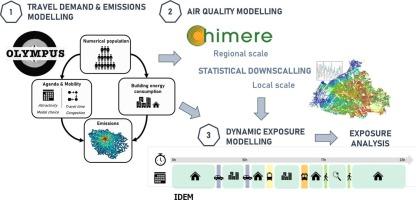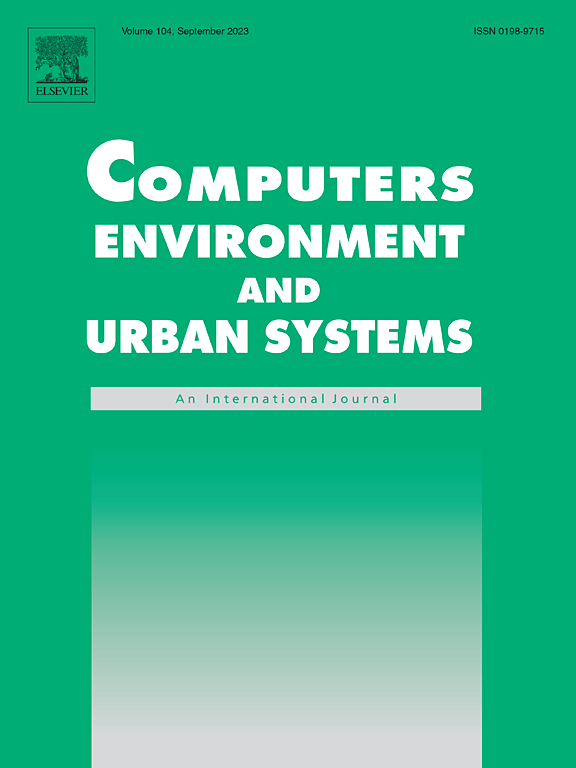重新评估空气污染暴露:日常流动性和活动如何影响大巴黎地区的个人风险
IF 8.3
1区 地球科学
Q1 ENVIRONMENTAL STUDIES
Computers Environment and Urban Systems
Pub Date : 2025-08-26
DOI:10.1016/j.compenvurbsys.2025.102340
引用次数: 0
摘要
了解个人暴露于空气污染的情况对于解决环境不平等问题和为旨在减少不平等的公共政策提供信息至关重要。传统方法通常侧重于住宅地点,但暴露与日常流动性、活动和社会经济状况有着内在联系。这项研究提出了基于动态暴露建模方法的新结果,该方法考虑了这些因素,提供了更现实的空气污染风险评估。通过将高分辨率空气质量数据与个人流动性、活动和社会经济特征的详细信息相结合,我们量化了Île-de-France地区40万人的暴露情况。我们的方法考虑了个人在白天访问的所有环境以及在每个环境中花费的时间,超越了基于居住地点的静态暴露评估。我们将该动态模型与传统的暴露计算方法进行了比较,发现PM10和NO2暴露的空间分布存在显著差异。我们的分析强调了移动模式和日常活动对总暴露的影响,表明居住地只是现实的一部分。例如,通勤、工作场所和休闲活动在决定个人暴露水平方面起着关键作用。我们的研究结果表明,动态暴露计算可以更好地理解暴露因素,并为理解环境不平等提供一个框架。通过将重点从以家庭为基础的接触转移到以个人为基础的接触,我们的方法可以确定采取行动的杠杆,以缩小差距并支持有针对性的公共卫生行动。我们的研究通过强调考虑移动行为和个人轨迹的必要性,重新定义了我们评估空气污染相关风险的方式。本文章由计算机程序翻译,如有差异,请以英文原文为准。

Reassessing air pollution exposure: How daily mobility and activities shape individual risk in greater Paris
Understanding individual exposure to air pollution is essential for tackling environmental inequalities and informing public policies aimed at reducing disparities. Traditional approaches often focus on residential locations, but exposure is intrinsically linked to daily mobility, activities and socio-economic profiles. This study presents new results based on a dynamic exposure modelling approach that takes these dimensions into account, offering a more realistic assessment of air pollution risk. By integrating high-resolution air quality data with detailed information on individual mobility, activities and socio-economic characteristics, we quantify the exposure of 400,000 individuals in the Île-de-France region. Our approach takes into account all the environments that individuals visit during the day and the time spent in each of them, going beyond static exposure assessments based on residential location. We compare this dynamic model with traditional exposure calculations, revealing significant differences in the spatial distributions of PM10 and NO2 exposure. Our analysis highlights how mobility patterns and daily activities contribute to total exposure, demonstrating that place of residence is only one part of reality. For example, commuting, workplaces and leisure activities play a key role in determining individual exposure levels. The results of our study show that dynamic exposure calculation provides a better understanding of exposure factors and offers a framework for understanding environmental inequalities. By shifting the focus from home-based to person-based exposure, our approach makes it possible to identify levers for action to reduce disparities and support targeted public health action. Our study redefines the way in which we assess the risks associated with air pollution, by highlighting the need to take into account mobility behaviour and individual trajectories.
求助全文
通过发布文献求助,成功后即可免费获取论文全文。
去求助
来源期刊

Computers Environment and Urban Systems
Multiple-
CiteScore
13.30
自引率
7.40%
发文量
111
审稿时长
32 days
期刊介绍:
Computers, Environment and Urban Systemsis an interdisciplinary journal publishing cutting-edge and innovative computer-based research on environmental and urban systems, that privileges the geospatial perspective. The journal welcomes original high quality scholarship of a theoretical, applied or technological nature, and provides a stimulating presentation of perspectives, research developments, overviews of important new technologies and uses of major computational, information-based, and visualization innovations. Applied and theoretical contributions demonstrate the scope of computer-based analysis fostering a better understanding of environmental and urban systems, their spatial scope and their dynamics.
 求助内容:
求助内容: 应助结果提醒方式:
应助结果提醒方式:


